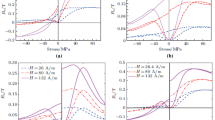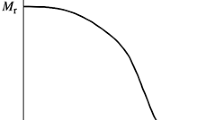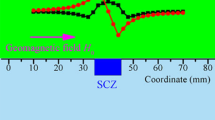A new nondestructive monitoring method is considered, i.e., a metal magnetic memory method, based on measuring the self-magnetization leakage field (SMLF) at the surface of test equipment. The method makes it possible to obtain the stressed state without considering structural changes. The magnetic memory effect is applied to the working areas of applied maximum loads during testing. The metal magnetic memory method does not have disadvantages compared with other monitoring methods, and makes it possible to recognize elastic deformation, the determine the plane of metal layer sliding, and also the area of fatigue crack development. Considering labor expenditure, it is possible to say that the metal magnetic memory method belongs to rapid methods. The main aim of the method is determination of the most critical areas and equipment having stress concentration.
Similar content being viewed by others
Avoid common mistakes on your manuscript.
It is well known that the main sources of damage development for gas pipelines, equipment, and structures are stress concentration zones (SCZ) due to operating loads. Whence it follows that a reliability criterion for equipment in operation is its actual stress-strained state (SSS). For opportune revelation of equipment assemblies predisposed towards damage, technical diagnosis methods are required correlated with mechanical stresses.
An effective method in evaluating the SSS of equipment, which is currently widespread in practice, is that of metal magnetic memory (MMM).
Processes preceding operational damage are changes in metal properties (corrosion, fatigue) in a SCZ and deformation. Correspondingly there is a change in metal magnetization, reflecting the actual state of pipelines and equipment.
The MMM method, based on measuring the self-magnetization leakage field (SMLF) at the surface of equipment being monitored, makes it possible to evaluate its SSS taking account of structural changes. The MMM effect is used in monitoring zones of the action of maximum operating loads.
The MMM method is free from disadvantages present in other methods for monitoring stresses and makes it possible (there are criteria) to distinguish a region of elastic strains from plastic, to determine areas of metal layer slip, and those of fatigue crack generation. If a crack has already formed, the method makes it possible to reveal crack “branching” (development direction) within a metal structure and makes to determine whether a crack develops or not.
The problem of sudden fatigue failure of equipment using traditional nondestructive monitoring methods cannot be resolved since they are aimed at finding defects already developed. MM monitoring, by accomplishing early equipment diagnosis, makes it possible to resolve this problem.
The main advantages of the new nondestructive monitoring method compared with known methods are:
-
1) it does not require use of special magnetizing devices, since it uses the phenomenon of pipe magnetization and other equipment assemblies during their operation;
-
2) areas of stress concentration are previously unknown and determined during monitoring;
-
3) it does not require cleaning of metal or any other preparation of a monitored surface; and
-
4) instruments are used that are small in size in order to perform monitoring, with self supply and recording devices.
In individual cases, it is possible to monitor equipment without removing insulation.
With respect to labor content, MMM-monitoring is a rapid method. Specialized small instruments with a screen and a recording device make it possible to carry out monitoring at a rate of 100 m/h or more.
The main task of MMM-monitoring is determination within an object of the most critical areas and assemblies having a SCZ. Then using, for example, a USD it is determined whether the SCZ has a specific defect.
The most effective use of MMM-monitoring is for evaluating equipment life. On the basis of evaluating the actual SS of structures there is a possibility for strengthening it, removal of a damaged metal layer, or replacement of a worn assembly within it.
Currently in many branches of industry within Russia on the basis of the MMM method more than forty guides have been developed and used, coordinated with technical supervision.
In 2010, the MM method was included by Rostekhnadzor in a list of basic magnetic methods recommended for use in critical industrial objects.
In 2009, Rostekhregulirovanie approved GOST ISO 9712 “Nondestructive monitoring. Personnel verification and certification” within Russia.
This standard put into practice a new form of monitoring, i.e., stress monitoring. In accordance with this standard in September 2010 Rostekhnadzor approved a Provision for certification of personnel in the field of nondestructive monitoring of a stress-strained state (NM SSS).
The MMM method in this provision is an effective method recommended for use in practice and correspondingly for verification and certification of personnel in the field of NM SSS.
The MMM method, being a fundamentally new area in technical diagnosis, has undergone extensive industrial verification (for more than 20 years) both within Russia and other countries. In November 2007, this method adopted the international standard ISO 24497: part 1 is terminology; part 2 is general specifications, and part 3 is welded joint monitoring.
In the period 1994–2009, 45 documents were issued from the International Institute of Welding (IIW) with proposed resolutions for the MMM method.
The enterprise Energodiagnostika has developed and mass produced specialized monitoring instruments and software for them:
-
a magnetometric stress concentration meter IKNM-2FP;
-
an electromagnetic crack indicator EMIT-1M, EMIT-2M;
-
stress concentration meters IKN-1M-4, IKN-2M-8, IKN-3M-12, IKN-4M-16, IKN-5M-32, IKN-6M-8;
-
MPM-Sistema software for processing MMM monitoring results in a computer with operation in Windows 95/2000/XP/Vista; and
-
MPM-Resurs software.
The instruments have been certified in the Federal Agency for Technical Regulation and Metrology (certificates RU.C.34.003.A No. 22257, RU.C.34.003.A No. 22258, and RU.C.27.002.A No. 35003).
The MMM method and corresponding monitoring instruments are used by more than 1000 Russian enterprises. Apart from Russia, the method has been approved and introduced into individual enterprises in 29 countries of the world, among which are Belarus, Germany, India, Canada, Kazakhstan, China, Poland, USA, Ukraine, Finland, Czech Republic, etc.
Starting from 1996, in Moscow a Russian and international center operates for training of specialists for the MMM method with presentation of certificates at levels I, II, and III, i.e., an independent department for personnel certification (IDPC) Energodiagnostika. In Warsaw and Beijing there are branches of this center. As of 2010 more than 1600 specialists have been trained, more than 350 specialists in China, 70 specialists in Poland, and more than 60 specialists in other countries.
In 1999, 2001, 2003, 2007, and 2009, within Moscow there have been five international conferences “Diagnosis of equipment and structures using the metal magnetic memory method.” The proceedings of the conferences have been considered at special meetings of the IIW. In Moscow in February 2011 the sixth international conference for the MMM method was held. Papers were presented at the conference on the following themes:
-
1) Results of developing the MMM method in Russia and other countries.
-
2) Experience of using the MMM method in monitoring and evaluating the life of gas pipelines and equipment for power generation, petrochemical, railway transport, and other branches of industry.
-
3) Criteria of a limiting metal condition in evaluating residual life; SSS monitoring for equipment and structures.
-
4) Monitoring of engineering component quality for structural inhomogeneity and residual stresses.
-
5) New Russian and international standards in the field of technical diagnostics; experience of the Russian Scientific and Technical Welding Society (RNTSO) in the field of standardization through the IIW.
-
6) Training of specialists for the MMM method both in the field of SSS monitoring and technical diagnosis in NOAP NK Energodiagnostika.
-
7) Experience and development prospects for contactless magnetometric monitoring of gas and oil pipelines, heating supply pipelines, located beneath a layer of soil, and in channels with difficult access.
More than 90 specialists from Russia, Poland, Hungary, Czech Republic, Ukraine, Lithuania, Latvia, and Mongolia took part in the conference.
Author information
Authors and Affiliations
Additional information
IX Scientific and Technical Conference with International Participation: Research, Designing, Manufacture, Standardization, and Technical Diagnosis of Equipment and Pipelines Operating under Pressure, September 21–23, 2011, Irkutsk, Russia
(Continuation. For initial papers, see No. 10 and No. 11, 2011)
Translated from Khimicheskoe i Neftegazovoe Mashinostroenie, No. 12, pp. 28–29, December, 2011.
Rights and permissions
About this article
Cite this article
Dubov, A.A. Development of a metal magnetic memory method. Chem Petrol Eng 47, 837–839 (2012). https://doi.org/10.1007/s10556-012-9559-6
Published:
Issue Date:
DOI: https://doi.org/10.1007/s10556-012-9559-6




